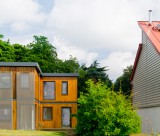The University of Nottingham
 Exchange online
Exchange online
Research Exchange
Audio walk to reveal the climatic history of British beauty spot

A new audio walk developed by University of Nottingham researchers is to help walkers at a Cumbrian beauty spot to unlock its rich history and learn about the dramatic climate and weather conditions that shape its landscape.
The audio walk, which has been written by a team in the University’s School of Geography, will be narrated by legendary weather broadcaster and former Met Office stalwart John Kettley, who will guide visitors on a 10-mile walk up Great Dun Fell, the second highest hill in the English Pennines.
An experimental smartphone app to accompany the walk is also being developed by the team.
The walk is part of the Royal Geographical Society’s (with the Institute of British Geographers) Discovering Britain project aimed at encouraging the public to explore the stories behind Britain’s landscapes.
The walk resources, freely available to download in both mp3 and printed formats, will reveal to walkers how the region is home to the UK’s only ‘named’ wind, the Helm Wind, and document its links with Gordon Manley FRGS, the celebrated climatologist, who studied this powerful natural phenomenon in the late 1930s.
Georgina Endfield, Professor of Environmental History, said: “The British weather is very much a part of our national identity — in fact you could argue that we are obsessed with it. It’s an easy topic to begin a conversation. But it’s also the case that people often remember key events in association with the weather at the time. Weather becomes parts of peoples’ lives, in this way. Manley recognised and was intrigued by this association and it is his work on weather, place, and culture that is framing this overall study.”
John Kettley began his career as a weather broadcaster at the BBC in Nottingham in 1980 — complete with old-style magnetic weather symbols — where he spent five years advising the city’s people on whether to pack the sun cream or umbrella before moving on to the national BBC bulletins.
John said: “I love to hear people getting excited about weather, it really has become a ‘sexy’ topic in recent years, and from my own upbringing in West Yorkshire I’m also a big fan of getting out and about in the great outdoors.
“If you combine that with the connection to Gordon Manley — whose book Climate and the British Scene was the first I ever owned on weather as a 10-year-old boy — this project presented me with an ideal opportunity.”
Great Dun Fell lies in the north of the Pennines — often described as the ‘backbone of England’— and rises to 2,782 feet at its peak. Its summit experiences some of the most extreme weather conditions in the UK and is famed for its connection to the Helm Wind, which has been both feared and celebrated by locals for centuries.
The circular walk — recommended for more experienced walkers — starts in the nearby village of Knock before wending its way up through open moorland to the summit and returns via a road thought to be the highest in Britain.
The audio will provide information and John’s commentary at key points along the way. Visitors will hear how Gordon Manley established a climatological station at Moor House, the ‘most remote house in England’ and began to take meteorological observations in January 1932. Manley’s own notes talk of the hard life Moor Cottage’s inhabitants, the Armstrong family, endured — in the winter of 1931 their daughter was unable to go to school for eight weeks due to deep snow and at Christmas 1940 a blizzard created a drift that reached more than halfway up the stairs in the cottage.
Despite its remote location, local people were still affected by the Second World War that raged across Europe. In 1940, Mrs Armstrong wrote of 10 bombs being dropped at High Force, Britain’s highest waterfall around five miles from Moor Cottage, with rumours circulating that Manley’s weather observations were being viewed with suspicion by Hitler’s Germany.
However, it is the Helm Wind, which sits at the heart of Manley’s research, which is likely to most fire the imagination of visitors to this bleak but beautiful spot. A true ‘local’ wind because it is a product of the specific landscape and climatic conditions, its force has caused devastation and even deaths over the centuries.
One account from the local newspaper The Westmorland Gazette, in 1831 reads: “About noon the Helm Wind was so heavy that it carried up the peats high into the air in its whirling eddies, scattering them in all directions, the horse became terrified and set off at a gallop, rushing headlong down a precipitous rock, crag, or scar, and was killed dead on the spot.”
In a series of interviews with locals more than 200 years later, people told stories of farm machinery being blown out of farmyards and sheep flying around like pieces of wool. One resident who went out into his garden during the Helm quickly retreated indoors because Brussels sprouts were being blown off their stalks and ricocheting around the garden like green machine gun bullets!
The walk commentary also includes extracts from the text of a radio interview with Manley in which he talks from personal experience of the Helm’s ‘roaring torrent of air’.
The walk also takes in the site of a weather recording station built by Manley near the summit as well as the radar station built in 1948 by the Civil Aviation Authority and used today by the Centre for Atmospheric Science at the University of Manchester for research into the behaviour of clouds.
The creation of the walk and app, led by Georgina Endfield, Lucy Veale, Gary Priestnall, Sam Meek and Simon Naylor (Exeter), has been funded as part of an ongoing project funded by Arts and Humanities Research Council (AHRC) Weather Walks and Weather Talks: Exploring Popular Climate Histories and Futures.
The team is currently recruiting volunteers for testing the walk and associated app in the Spring and would be delighted to hear from people interested in participating.
More information is available on the web at: http://www.discoveringbritain.org/walks/region/north-west-england/great-dun-fell.html
Leave a Reply
Other

Top prize for quantum physicist
A University of Nottingham physicist has won a prestigious medal from the Institute of Physics for […]

Zero carbon HOUSE designed and built by students comes home
Design and construct a low cost, zero carbon, family starter home, transport it to Spain, build […]